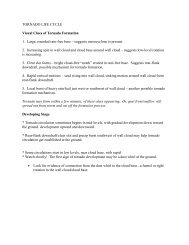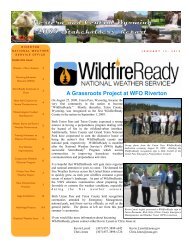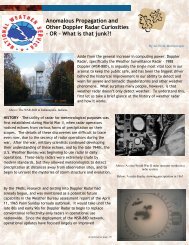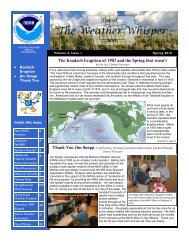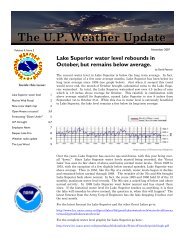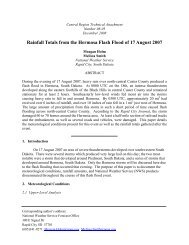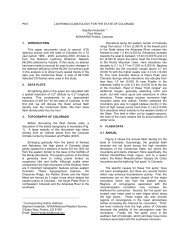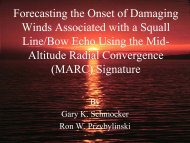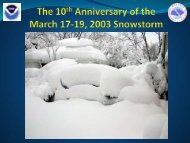Red Flag Pattern Recognition Methodology - NOAA
Red Flag Pattern Recognition Methodology - NOAA
Red Flag Pattern Recognition Methodology - NOAA
You also want an ePaper? Increase the reach of your titles
YUMPU automatically turns print PDFs into web optimized ePapers that Google loves.
Title Page<br />
<strong>Red</strong> <strong>Flag</strong> <strong>Pattern</strong> <strong>Recognition</strong> for the Western<br />
Foothills Region of the Southern Appalachian<br />
Mountains<br />
by Tony Edwards<br />
General Forecaster & IMET<br />
WFO Jackson, KY<br />
<strong>NOAA</strong>’s National Weather Service
<strong>Red</strong> <strong>Flag</strong> <strong>Pattern</strong> <strong>Recognition</strong><br />
Goals<br />
GOALS<br />
•Define weather patterns that frequently result in <strong>Red</strong> <strong>Flag</strong> conditions across<br />
the region encompassed by eastern Kentucky, southwestern West Virginia,<br />
southwest Virginia and eastern Tennessee.<br />
•Allow for quicker detection of <strong>Red</strong> <strong>Flag</strong> Conditions by fire<br />
weather forecasters.<br />
•More lead time for our users…<br />
<strong>NOAA</strong>’s National Weather Service
<strong>Red</strong> <strong>Flag</strong> <strong>Pattern</strong> <strong>Recognition</strong><br />
<strong>Methodology</strong><br />
<strong>Methodology</strong><br />
• Identify <strong>Red</strong> <strong>Flag</strong> Days<br />
•<strong>Red</strong> <strong>Flag</strong> Criteria –<br />
•20-ft Wind >= 15 mph<br />
•RH
<strong>Red</strong> <strong>Flag</strong> <strong>Pattern</strong> <strong>Recognition</strong><br />
<strong>Methodology</strong><br />
<strong>Methodology</strong><br />
•Sorted occurrences into regions when needed…<br />
•Regionwide <strong>Red</strong> <strong>Flag</strong> Days…<br />
•East Kentucky Only…<br />
•Tennessee Only…<br />
•Northeast Sector (northeast Tennessee, southwest Virginia, southern West<br />
Virginia…<br />
•Analyzed surface charts to find patterns for further sorting<br />
•Pre-Frontal<br />
•Post-Frontal<br />
•Combined all cases into either Pre-Frontal and Post-Frontal per region and<br />
analyzed CDC Reanalysis Data composite upper air charts per dates.<br />
•http://www.cdc.noaa.gov/NARR/<br />
<strong>NOAA</strong>’s National Weather Service
<strong>Red</strong> <strong>Flag</strong> <strong>Pattern</strong> <strong>Recognition</strong><br />
Prefrontal<br />
Regionwide RFD<br />
•Upper level features to key in on are a digging H5 trough upstream over<br />
the Rockies/Northern Plains/Canadian Prairies.<br />
<strong>NOAA</strong>’s National Weather Service
<strong>Red</strong> <strong>Flag</strong> <strong>Pattern</strong> <strong>Recognition</strong><br />
Prefrontal<br />
Regionwide RFD<br />
•Mid and upper levels indicate diving trough into the upper Midwest, with<br />
strong H850 jet located over the Ohio Valley.<br />
<strong>NOAA</strong>’s National Weather Service
<strong>Red</strong> <strong>Flag</strong> <strong>Pattern</strong> <strong>Recognition</strong><br />
Prefrontal<br />
Regionwide RFD<br />
•While moist tongue is located just to our west, surging northeast up the<br />
Ohio Valley, dry air is noted aloft over the southern Appalachians.<br />
<strong>NOAA</strong>’s National Weather Service
<strong>Red</strong> <strong>Flag</strong> <strong>Pattern</strong> <strong>Recognition</strong><br />
Regionwide RFD<br />
Prefrontal<br />
•Classic setup involves a strong surface ridge along southeast coastline<br />
with low pressure and associated cold front diving into the upper Midwest.<br />
13 mb or greater gradient needed<br />
<strong>NOAA</strong>’s National Weather Service
<strong>Red</strong> <strong>Flag</strong> <strong>Pattern</strong> <strong>Recognition</strong><br />
Prefrontal Event Case Study<br />
Case Study<br />
February 13, 1990<br />
<strong>NOAA</strong>’s National Weather Service
<strong>Red</strong> <strong>Flag</strong> <strong>Pattern</strong> <strong>Recognition</strong><br />
Prefrontal Event Case Study<br />
Case Study<br />
February 13, 1990<br />
•H850 Trough over the Upper Midwest with moisture return well to our<br />
west. Note dry air from the Appalachians eastward.<br />
<strong>NOAA</strong>’s National Weather Service
<strong>Red</strong> <strong>Flag</strong> <strong>Pattern</strong> <strong>Recognition</strong><br />
Prefrontal Event Case Study<br />
Case Study<br />
February 13, 1990<br />
•Prefrontal cases have a strong southwesterly low level jet which we mix<br />
up into creating gusty winds to go along with the low surface RH.<br />
<strong>NOAA</strong>’s National Weather Service
<strong>Red</strong> <strong>Flag</strong> <strong>Pattern</strong> <strong>Recognition</strong><br />
Prefrontal Event Case Study<br />
Case Study<br />
February 13, 1990<br />
•Pressure gradient is approximately 19 mb between ridge off the Carolina<br />
coast and the low over KS/OK. Note strong gusty winds in the observations.<br />
<strong>NOAA</strong>’s National Weather Service
<strong>Red</strong> <strong>Flag</strong> <strong>Pattern</strong> <strong>Recognition</strong><br />
Regionwide Postfrontal<br />
Regionwide RFD<br />
•At H500 upper level shortwave or vertically stacked occluded system is<br />
usually positioned over the Great Lakes or Upper Midwest with a strong<br />
westerly jet over the Ohio Valley.<br />
<strong>NOAA</strong>’s National Weather Service
<strong>Red</strong> <strong>Flag</strong> <strong>Pattern</strong> <strong>Recognition</strong><br />
Regionwide Postfrontal<br />
Regionwide RFD<br />
•Dry slot then punches in during the afternoon. We scatter out and mix up<br />
into this dry air aloft. RH plummets along with gusty winds. Guidance<br />
does not handle this well at all.<br />
<strong>NOAA</strong>’s National Weather Service
<strong>Red</strong> <strong>Flag</strong> <strong>Pattern</strong> <strong>Recognition</strong><br />
Postfrontal Event Case Study<br />
Case Study<br />
April 6 th , 1999<br />
<strong>NOAA</strong>’s National Weather Service
<strong>Red</strong> <strong>Flag</strong> <strong>Pattern</strong> <strong>Recognition</strong><br />
Postfrontal Event Case Study<br />
Case Study<br />
April 6 th , 1999<br />
•Mid and Upper Level Trough centered over the Upper Midwest/Great Lakes moving<br />
eastward through the day.<br />
<strong>NOAA</strong>’s National Weather Service
<strong>Red</strong> <strong>Flag</strong> <strong>Pattern</strong> <strong>Recognition</strong><br />
Postfrontal Event Case Study<br />
Case Study<br />
April 6 th , 1999<br />
•Surface cold frontal passage around midday with lagging H850 trough and clear skies allowed<br />
strong warming and deep mixing during the afternoon.<br />
40kts<br />
overhead<br />
@ H850<br />
<strong>NOAA</strong>’s National Weather Service
<strong>Red</strong> <strong>Flag</strong> <strong>Pattern</strong> <strong>Recognition</strong><br />
<strong>Methodology</strong><br />
Summary<br />
• Prefrontal<br />
•500 mb – Digging trof over Nrn Plains or Rockies<br />
•850 mb – Trof over Upper Midwest<br />
•Strong LLVL Jet over Ohio Valley<br />
•Moist Tongue West/Dry Air Above<br />
•Surface –<br />
•Strong High over the Deep South/Florida<br />
•Deep Low over Upper Midwest with trailing<br />
cold front<br />
•Pressure gradient of 13 mb or greater<br />
<strong>NOAA</strong>’s National Weather Service
<strong>Red</strong> <strong>Flag</strong> <strong>Pattern</strong> <strong>Recognition</strong><br />
<strong>Methodology</strong><br />
Summary<br />
• Postfrontal<br />
•Upper Levels<br />
•Surface<br />
•Vertically stacked upper low over the western<br />
Great Lakes<br />
•Strong jet over the Ohio Valley to be mixed<br />
into<br />
•850 mb trough axis lagging well behind<br />
surface frontal passage<br />
•Early morning frontal passage<br />
•Dry air nosing eastward across the plains<br />
can be noted on water vapor<br />
<strong>NOAA</strong>’s National Weather Service
<strong>Red</strong> <strong>Flag</strong> <strong>Pattern</strong> <strong>Recognition</strong><br />
<strong>Methodology</strong><br />
So, Does It Work!<br />
<strong>NOAA</strong>’s National Weather Service
<strong>Red</strong> <strong>Flag</strong> <strong>Pattern</strong> <strong>Recognition</strong><br />
<strong>Methodology</strong><br />
Tuesday March 25 th , 2008<br />
23/12Z NAM for 18Z Tuesday 25th<br />
<strong>NOAA</strong>’s National Weather Service
<strong>Red</strong> <strong>Flag</strong> <strong>Pattern</strong> <strong>Recognition</strong><br />
<strong>Methodology</strong><br />
Tuesday March 25 th , 2008<br />
<strong>NOAA</strong>’s National Weather Service
<strong>Red</strong> <strong>Flag</strong> <strong>Pattern</strong> <strong>Recognition</strong><br />
<strong>Methodology</strong><br />
Tuesday March 25 th , 2008<br />
24/12Z NAM for 18Z Tuesday 25th<br />
<strong>NOAA</strong>’s National Weather Service
<strong>Red</strong> <strong>Flag</strong> <strong>Pattern</strong> <strong>Recognition</strong><br />
<strong>Methodology</strong><br />
Tuesday March 25 th , 2008<br />
<strong>NOAA</strong>’s National Weather Service
<strong>Red</strong> <strong>Flag</strong> <strong>Pattern</strong> <strong>Recognition</strong><br />
<strong>Methodology</strong><br />
Tuesday March 25 th , 2008<br />
<strong>NOAA</strong>’s National Weather Service
<strong>Red</strong> <strong>Flag</strong> <strong>Pattern</strong> <strong>Recognition</strong><br />
<strong>Methodology</strong><br />
Tuesday March 25 th , 2008<br />
<strong>NOAA</strong>’s National Weather Service
INCIDENT METEOROLOGISTS (IMETS)<br />
Questions…Comments?<br />
<strong>NOAA</strong>’s National Weather Service<br />
weather.gov




